British Levant
The stamps issued at the British post offices in the wide area referred to as “British Levant” were issued with two types of overprint, either in Turkish currency, or simply with the word “LEVANT” without a currency change (the latter first issued in 1905). These were not separate areas of issue and were in use side by side; the latter were intended for parcels and printed matter, and for postcards, though they were also sometimes used as “make-up” values, creating mixed frankings with stamps in Turkish currency. However, since collectors normally treat them separately the same approach has been adopted below.
At various times unoverprinted British stamps were also officially used, especially before 1885, though some other denominations can also be found used if visitors or businesses happened to have British stamps in their possession. In 1919-1922 unoverprinted British stamps were also the normal issue in Constantinople and Smyrna (the only British offices to reopen after the war). Many other countries also operated post offices in the Levant areas.
Postal context
British Levant is the philatelic name for a number of post offices situated at the eastern end of the Mediterranean, and extending over the area of the Ottoman Empire from Salonica in Greece to Beyrout in Lebanon (now spelt Beirut). A treaty made in 1832 between Great Britain and Turkey allowed the British Government to establish post offices throughout the Ottoman Empire. Other European powers also signed similar treaties and set up their own post offices, so that just before the outbreak of the first World War in 1914 there were 103 foreign post offices operating in the area under the control of six countries, as a result of a series of agreements referred to as the “capitulations”. The presence of these offices had been an irritation to the Turkish government, resulting as it did from a long series of economic and political concessions by Turkey demanded by the western countries. At the start of the war in 1914 the capitulations were “abrogated”[1] by the Turkish authorities and all foreign post offices in Turkey were closed.
Post offices run by foreign governments in the region were only allowed to handle foreign mail going into or leaving each country. Local mail was generally handled by the Turkish Post Office, but where an addressee had a box in the post office local mail could be put in that box; mail has been found addressed to persons at the offices in Constantinople and Smyrna.
The first British post office in the area was opened in 1857 and initially only adhesive stamps were made available, but from 1 June 1875 unoverprinted postal stationery was sold. The exchange rate used was 2½d to 1 piastre (1 piastre comprised 40 paras). For reasons which are no longer apparent, values under 4 piastres were overprinted solely in paras, eg “80 paras” rather than “2 piastres”. This was subsequently addressed in 1905 and from then only values less than 1 piastre were quoted solely in paras. This rate of exchange continued through the period when other post offices were opened. But the Turkish currency depreciated, and by 1885 1 piastre was worth only 2d. The British authorities were concerned that it would be possible to purchase stamps and postal stationery in the British Levant post offices and return them to the United Kingdom where they could be legitimately used at what amounted to a subsidised price, or under the prevailing rules sell them back at face value at a post office in Britain. To prevent this from happening, stamps were overprinted with the value in Turkish currency from 1885; in 1893 the same approach was taken with postal stationery starting with the Queen Victoria 2½d envelopes.
The five British run post offices listed in the table below are those normally associated with British Levant postal matters. They sold and used both overprinted and unoverprinted stamps and postal stationery. All were closed on 30 September 1914 (Salonica, then as now in Greece, a week or so later) following the start of the first World War. Only two were reopened in 1919 and both of these were finally closed three or four years later; Smyrna only used unoverprinted material after the reopening.
It should be noted that British post offices in other parts of the Turkish Empire (Alexandria, Cairo and Suez) did not use overprinted stamps and postal stationery and are often listed in catalogues as “GB used abroad” rather than as part of the “British Levant”.
The British post offices in the Levant, periods of opening
| Post Office located in: | Opened | Closed | Reopened after the war | Finally closed |
| Constantinople | 1 July 1857 | 30 September 1914 | February 1919 | September 1923 |
| Stamboul | April 1885 | 25 August 1896 | ||
| 10 February 1908 | 30 September 1914 | Not reopened | ||
| Smyrna | December 1872 | 30 September 1914 | 1 March 1919 | September 1922 |
| Beyrout (Lebanon) | March 1873 | 30 September 1914 | Not reopened | |
| Salonica (Greece) | 1 May 1900 | October 1914 | Not reopened | |
Constantinople:This was an army post office available to civilians in the period 4 February 1919 to 2 July 1920, after which it operated as a civilian post office until 27 September 1923.
Stamboul: This was a sub office of Constantinople and was closed between 25 August 1896 and 10 February 1908; the closure of the office in 1896 was caused by anti-Armenian riots.
Salonica: As this was in Greek territory rather than Turkish, the office was allowed by the Greek authorities to operate until late October 1914, later than the 30 September 1914 closure of the other offices as it was not directly affected by the abrogation of the Turkish capitulations.
For dates shown without a specific day it has not been possible to establish the exact day of opening or closing of the office.
Turkish currency
Turkish Currency: 40 paras = 1 piastre
Queen Victoria 1st Set

| (SG №) | denomination | colour | date of issue | number issued |
| 1 | 40 PARAS on 2½d | lilac | 1 August 1885 | 480,000 |
| 2 | 80 PARAS on 5d | green | 1 August 1885 | 120,000 |
| 3 | 12 PIASTRES on 2/6d, toned paper | lilac | 1 August 1885 | 5,800 |
| 3a | ditto on white paper | lilac | April 1888 | 30,192 |
No. 3 is often described as “blued” paper, though it is really a pale grey with a bluish sheen over the whole design, nothing at all like the earlier Victorian “blued paper” stamps; items offered for sale are often misidentified. The safest way to buy an example on toned paper is to get a mint one overprinted “SPECIMEN”, provided that this overprint is genuine. Collectors are advised that the American Scott catalogue reverses the order of the two types of paper.
Jubilee set
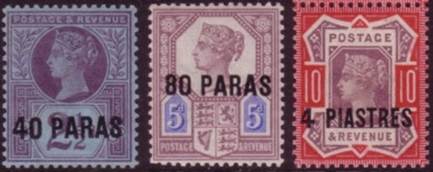
| (SG №) | denomination | colour | date of issue | number issued |
| 4 | 40 PARAS on 2½d | purple on blue | June 1887 | 5,199,000 |
| 5 | 80 PARAS on 5d | blue and purple | July 1890 | 381,420 |
| 6 | 4 PIASTRES on 10d | purple and red | 10 October 1896 | 45,780 |



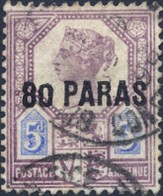




| Varieties | |||
| 4.v1 | 40 paras | overprint double | typically the extra overprint is shifted sideways |
| 4.v2 | 40 paras | broken letters | various examples are known, probably caused by material getting in the way, rather than real damage |
| 4.v3 | 40 paras | overprint badly misplaced | slight misplacements are common; this variety covers those where a significant part of the overprint overlaps the perforations and therefore appears on the wrong side of the stamp |
| 5.v1 | 80 paras | watermark inverted | |
| 5.v2 | 80 paras | small “0” in “80” | Stamps R4/1 and R4/7 of later printings. This was not corrected and can still be found on the King Edward VII issue, in more positions on the new larger sheets. |
| 5.v3 | 80 paras | “8” broken to read “3” (“30”) or “6” (“60”) | examples of broken letters or something blocking the overprint letters; they may not be constant. Other damaged letters are also known, but have no effect on the apparent rate of the overprint. |
| 6.v1 | 4 piastres | large wide “4” | This rather unobvious but well‑established variety occurs on stamps R1/2 and R1/4 |
| 6.v2 | 4 piastres | overprint misplaced | examples are known (The Overprinter 1999/3) with the overprint across the centre of the stamp instead of its proper place at the bottom; the normal overprint position aims to avoid covering the monarch’s head. |
40 paras provisional
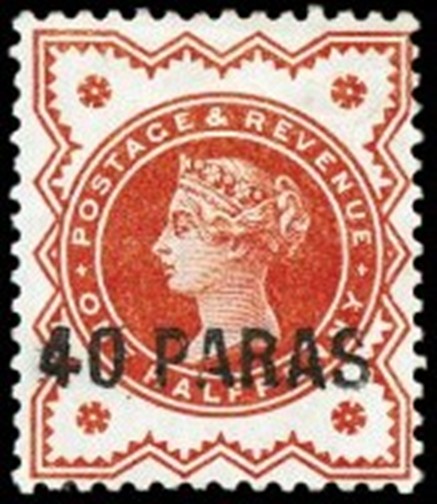
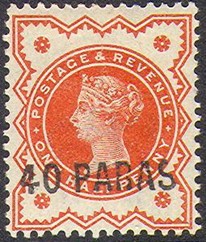
| (SG №) | denomination | colour | date of issue | number issued |
| 7 | 40 PARAS on ½d | orange | 25 February 1892 | 6,000 |
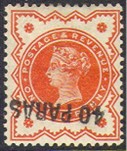
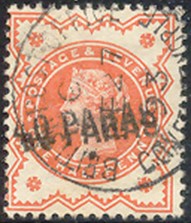

Controls
No examples with control letter are recorded, but it is assumed that the control on the sheets used would have been “J”, that being the latest contemporary printing.
Examples of the overprint misplaced or at an angle attract no particular premium.
| Varieties | ||
| 7.v1 | overprint inverted | |
| 7.v2 | overprint double | |
| 7.v3 | overprint double one inverted | |
| 7.v4 | overprint omitted | se‑tenant with overprinted stamp (The Overprinter 1997/4) |
This provisional, in use in Constantinople for only 5 days, was unauthorised and some feel was philatelic; most examples (including those used on piece) were produced after it was withdrawn using the original handstamp and, in the case of used copies, a postmark using the same canceller as used during the period of currency. Pieces of paper exist with multiple copies cancelled to order still affixed. The London officials instructed the local postmaster to withdraw them. The overprinter suffered damage to the final “S” after its supposed withdrawal, and examples with this fault are almost certainly CTO examples after the date of “withdrawal”, with a false date in the canceller. There are numerous forgeries and bogus varieties.
King Edward VII
All the overprints in Turkish currency were on denominations which did not use control letters in the margin.
De La Rue printing on ordinary paper

| (SG №) | denomination | colour | date of issue | number issued |
| 8 | 40 PARAS on 2½d | blue | March 1902 | 2,078,160 |
| 9 | 80 PARAS on 5d | blue and purple | 5 June 1902 | 118,320 |
| 10 | 4 PIASTRES on 10d | purple and red | 6 September 1902 | 37,632 |
| 11 | 12 PIASTRES on 2/6d | lilac | 29 August 1903 | 13,832 |
| 12 | 24 PIASTRES on 5s | red | 15 August 1905 | 11,032 |


| Varieties | |||
| 8.v1 | 40 paras | overprint double | The known examples are very close and may be “kiss-prints” |
| 9.v1 | 80 paras | small “0” in “80” | Stamps R4/1, R4/7, R14/1 and R14/7 of the first printing. The King Edward VII sheet size was 240 rather than the 120 of the Queen Victoria issue, but used the same 120-image overprinting plate, so this variety can be found on the top half and the bottom half of the sheet |
De La Rue on chalky paper
From 1907 De La Rue used chalk-surface paper to provide a better image, though it is more inclined to suffer from surface abrasion. New denominations were also introduced.
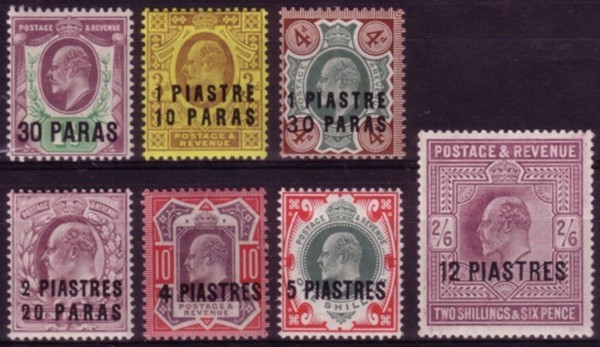
| (SG №) | denomination | colour | date of issue | number issued |
| 16 | 30 PARAS on 1½d | green and purple | 16 November 1909 | 81,120 |
| 17 | 1 PIASTRE 10 PARAS on 3d | purple on yellow | 16 November 1909 | 82,320 |
| 18 | 1 PIASTRE 30 PARAS on 4d | green and brown | 16 November 1909 | 21,840 |
| 20 | 2 PIASTRES 20 PARAS on 6d | purple | 16 November 1909 | 83,040 |
| 10b | 4 PIASTRES on 10d | purple and red | 6 September 1902 | 23,904 |
| 21 | 5 PIASTRES on 1s | green and red | 16 November 1909 | 41,400 |
| 11a | 12 PIASTRES on 2/6d | lilac | 29 August 1903 | 9,688 |
Some catalogues list an error “overprint double, one albino” on No. 14, but some experts consider it an accidental duplicate entry of the same error on No. 33, the Somerset House printing (GBOS Study Paper 2).
De La Rue, change of colour of the 4d
Because of large quantities needed in Britain, the 2-colour format of the 4d was changed to just orange; this was part of a policy to move to single-colour stamps, though the death of King Edward VII stopped its full implementation (the 2d “Tyrrhian plum” would have been another example had it been issued). The Levant overprint on the orange stamp was issued only 1 month after the 2-colour version listed above, though collectors bought large numbers of the latter when withdrawal was announced, so that they are not scarce.
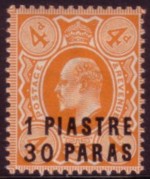
| (SG №) | denomination | colour | date of issue | number issued |
| 19 | 1 PIASTRE 30 PARAS on 4d | orange | 16 December 1909 | 59,280 |
De La Rue simplification of the overprint
Since there were 40 paras in a piastre, some of the above rather wordy and cluttered overprints could be simplified; these do not represent a change in denomination, merely the way it is shown in the overprint. It is not clear why the complicated wording was adopted in the previous issues (including the Queen Victoria stamps) unless it was to meet local custom and practice. This change of wording overlapped the change from ordinary to chalky paper.
Ordinary paper
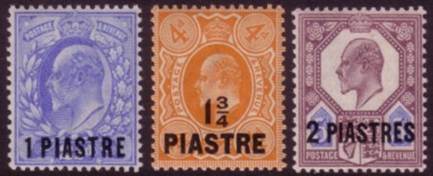
| (SG №) | denomination | colour | date of issue | number issued |
| 13 | 1 PIASTRE on 2½d | ultramarine | 17 April 1906 | 3,032,640 |
| 23 | 1¾ PIASTRE on 4d | orange | 24 January 1910 | 119,280 |
| 14 | 2 PIASTRES on 5d | blue and purple | 11 November 1905 | 70,800 |

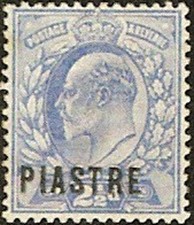
| Varieties | |||
| 13.v1 | 1 piastre | overprint double | The known examples are very close and may be “kiss-prints” |
| 13.v2 | 1 piastre | overprint badly misplaced | To count as this variety the “1” must have shifted off the left of the stamp and appear at the right “PIASTRE 1”. Examples with the 1 over the perforations are less scarce. Examples from the right-hand end of the row would have no “1” at the right, but beware of faked examples created by rubbing out the remains of the “1” at the left or right (these can be identified it the space left of “P” extends over where the “1” would be found (which may be the case with the illustration above. (No image available of a fully shifted overprint reading “PIASTRE 1”, reported in The Overprinter 1985/3, p..79.) |
| 13.v3 | 1 piastre | watermark inverted | 2 copies are known: a mint copy with the watermark misplaced upwards to straddle the horizontal perforations, and a used copy with the inverted watermark in the normal position; there must therefore have been at least 2 sheets affected. |
Chalky paper
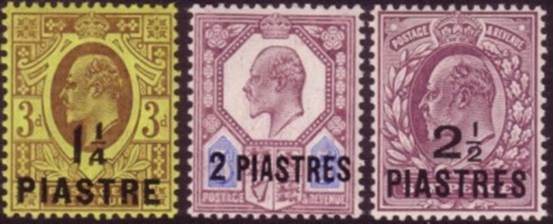
| (SG №) | denomination | colour | date of issue | number issued |
| 22 | 1¼ PIASTRES on 3d | purple on yellow | 83,040 | |
| 14a | 2 PIASTRES on 5d | blue and purple | 141,360 | |
| 24 | 2 ½ PIASTRES on 6d | purple | 59,520 |
Provisional surcharge
In 1906 a provisional surcharge of 1 Piastre was applied to 2d stamps already overprinted “LEVANT”, due to short stocks of the 1 PIASTRE on 2½d stamp. However many specialists regard this as unnecessary speculative philatelic issue by the postmaster. It was only in use for 2 days. Examples with a wider (3mm) space after the “1” are considered forgeries, and there are numerous other forgeries usually identifiable from the precise shape of the letters in “I Piastre”.
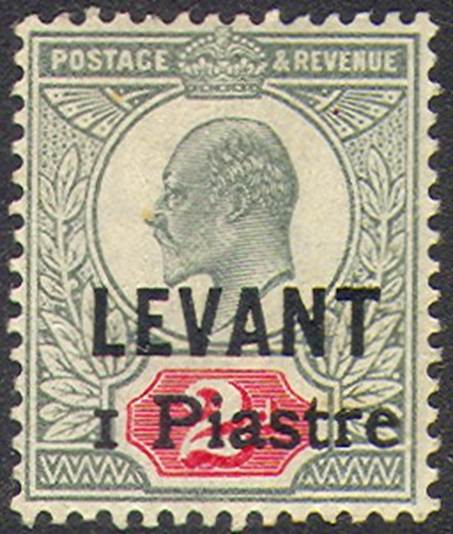
| (SG №) | denomination | colour | date of issue | number issued |
| 15 | 1 Piastre on 2d | red and green | 2 July 1906 | 480 |
1911 New printer, Harrisons
Harrisons only overprinted the “1 PIASTRE” on 2½d stamp, but it generated several variations in font and perforation as Harrisons were about to change the perforation gauge on low-value definitives.

The differences between the types are:
Type I, also used for No. 22: narrow “P” and “E” in PIASTRE
– Type I overprints are the most complex, having 2 printers and 2 perforations:
– No. 22 (De La Rue) is ultramarine, No. 29 (Harrisons) is bright blue, as are Nos 30-32.
Type II, wide “P” and “E”, narrow “A” in PIASTRE
Type III, as type II but squat much more open “A”
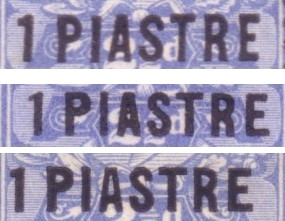
Type II (middle) wide “P”, “E”, narrow “A”
Type III (bottom) wide “P”, “E”, more open “A”
| (SG №) | denomination | colour | date of issue | number issued |
| 25 | 1 Piastre on 2½d type I perf 14 | blue | 20 July 1911 | 120,000 |
| 26 | ditto perf 15*14 | blue | 14 October 1911 | 180,000 |
| 27 | type II perf 15*14 | blue | March 1912 | 120,000 |
| 28 | type III perf 15*14 | blue | July 1912 | 480,000 |
Although the print run of type III was very large, it seems that the difference from type II was not spotted at the time as mint copies of type III are quite scarce.
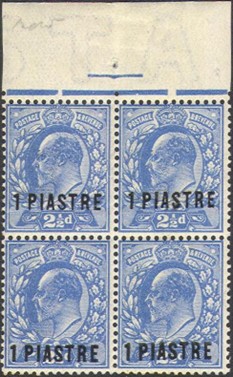
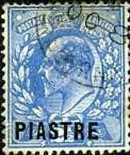
| Varieties | |||
| 25.v1 | 1 piastre | overprint double, one albino | on one sheet the top row missed the overprint and was reinserted to receive it, masking off the rest of the sheet; however this 2nd pass was higher than the original, so the top row has a misplaced overprint, and the 2nd row (under the masking) had received an albino overprint in the higher position used in row 1 as a well as its original overprint in the expected position (image ex Rossi, courtesy of Warwick & Warwick) xxxref in Overprinter |
| 25.v2 | 1 piastre | overprint misplaced | |
| 38.v1 | 1 piastre | overprint badly misplaced | see warning about fakes under 22.v2 |
1911, new printer for some values, Somerset house
The purple colours are very distinct from the earlier issues, being much brighter, deeper and redder; the other colours can less easy to distinguish between the 2 printers, especially the 5s. No. 35 (10d) No. 16 can be found in carmine and scarlet, No. 36 only in carmine.
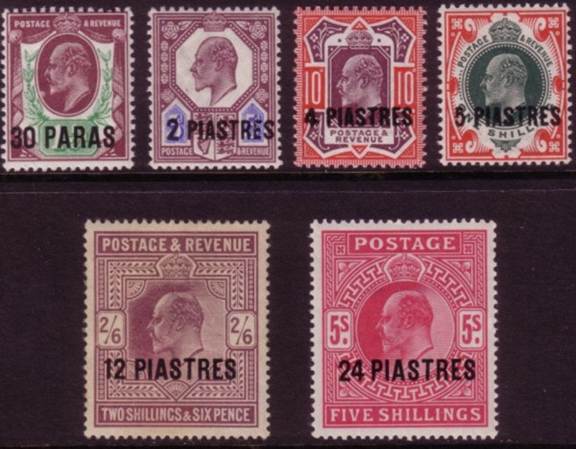
| (SG №) | denomination | colour | date of issue | number issued |
| 29 | 30 PARAS on 1½d | green and purple | 22 August 1911 | 120,000 |
| 30 | 2 PIASTRES on 5d | blue and purple | 13 May 1912 | 78,000 |
| 31 | 4 PIASTRES on 10d | purple and red | 26 June 1912 | 19,200 |
| 32 | 5 PIASTRES on 1s | green and red | 1913 | 12,000 |
| 33 | 12 PIASTRES on 2/6d | purple | 3 February 1912 | 7,000 |
| 34 | 24 PIASTRES on 5s | red | 1913 | 2,800 |
| Varieties | ||
| 29.v1 | 30 paras | overprint double one albino |
| 32.v1 | 5 piastres | overprint double one albino |
| 34.v1 | 24 piastres | overprint double one albino |
King George V
Wmk script cypher
By now all British stamps under 2/6d used control letters.
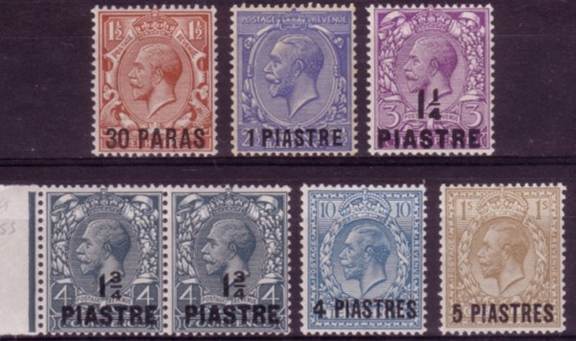
| (SG №) | denomination | colour | date of issue | number issued |
| 35 | 30 PARAS on 1½d | brown | April 1913 | not recorded |
| 36 | 1 PIASTRE on 2½d | blue | June 1913 | not recorded |
| 37 | 1¼ PIASTRE on 3d | violet | September 1913 | not recorded |
| 38 | 1¾ PIASTRE on 4d | green-grey | July 1913 | not recorded |
| 39 | 4 PIASTRES on 10d | blue | December 1913 | not recorded |
| 40 | 5 PIASTRES on 1s | brown | January 1914 | not recorded |
Controls containing a full stop are Somerset House printings
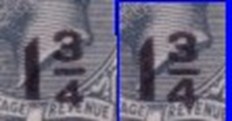
| Varieties | |||
| 35.v1 | 30 paras | overprint double one albino | |
| 37.v1 | 1¼ piastres | overprint double one albino | |
| 38.v1 | 1¾ piastres | thin pointed “4” in the fraction | 1st and 7th stamp in every row |
The British post offices were closed during World War II (see Table in paragraph 10.1), following the “abrogation of the capitulations”. The Turkish post office issued a set of stamps with commemorative overprint to mark this:
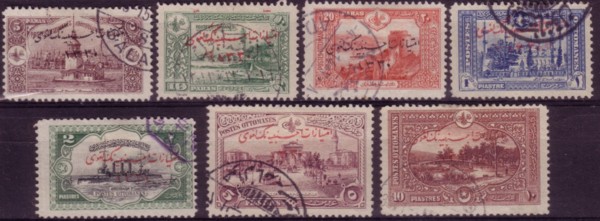
After World War II
When the Constantinople post office reopened after World War I the local currency had been considerably devalued, so replacement overprints were issued in a much larger font and with a different sterling equivalent – for example the 1913 10d stamp was overprinted “4 piastres” whereas the 1921 10d stamp bore “15 piastres”.
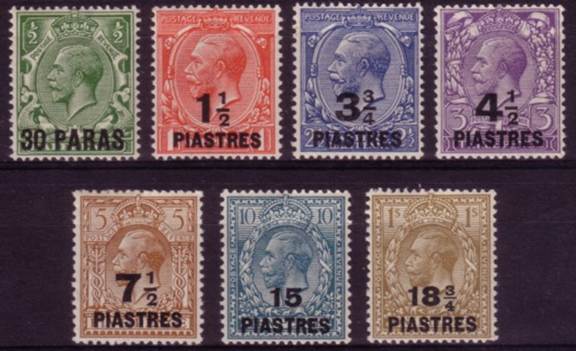

| (SG №) | denomination | colour | date of issue | number issued |
| 41 | 30 PARAS on ½d | green | August 1921 | not recorded |
| 42 | 1½ PIASTRES on 1d | red | August 1921 | not recorded |
| 43 | 3¾ PIASTRES on 2½d | blue | August 1921 | not recorded |
| 44 | 4½ PIASTRES on 3d | violet | August 1921 | not recorded |
| 45 | 7½ PIASTRES on 5d | brown | August 1921 | not recorded |
| 46 | 15 PIASTRES on 10d | blue | August 1921 | not recorded |
| 47 | 18¾ PIASTRES on 1s | brown | August 1921 | not recorded |
| 48 | 45 PIASTRES on 2/6d | brown | August 1921 | not recorded |
| 49 | 90 PIASTRES on 5/- | red | August 1921 | not recorded |
| 50 | 180 PIASTRES on 10s | blue | August 1921 | not recorded |
The “Seahorses” are Bradbury Wilkinson printings.
It is interesting to note that whereas the prewar values P1¼ and P1¾ worded the value as “PIASTRE” in the singular, in this set “1½ PIASTRES” is in the plural.
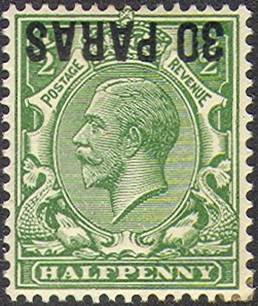
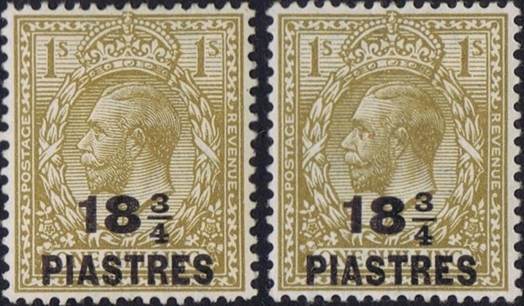
| Varieties | |||
| 41.v1 | 30 paras | overprint inverted | this variety is not listed in some catalogues as some experts regard it as a clandestine production using the genuine overprinting plate (this opinion arises solely from a comment in a RPSL certificate). |
| 47.v1 | 18¾ piastres | spaced fraction | |
| 48.v1 | 45 piastres | “45” joined | the numerals are joined on stamp 2 of each row, though sometimes it is less prominent depending on the level of inking and pressure |
| 48.v2 | 45 piastres | ribbed paper | this is not formally laid paper but has a definitely ribbed texture |
| 49.v1 | 90 piastres | ribbed paper | this is not formally laid paper but has a definitely ribbed texture |
| 49.v2 | 90 piastres | overprint double, one albino | only one copy has been recorded so far (The Overprinter 1998/4) |
| 50.v2 | 180 piastres | overprint double, one albino | only 3 copies have been recorded so far (Rossi auction list) |
British currency, “LEVANT” overprint
De La Rue printings, ordinary paper
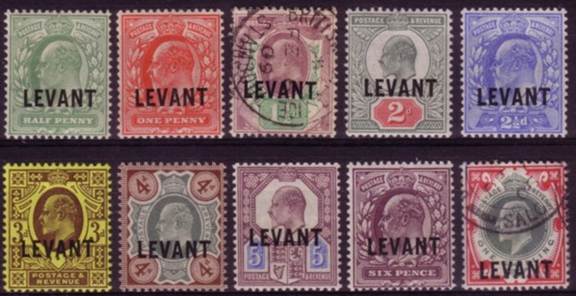
| (SG №) | denomination | colour | date of issue | number issued |
| L1 | ½d | green | 15 August 1905 | 981,360 |
| L2 | 1d | red | 15 August 1905 | 980,400 |
| L3 | 1½d | green and purple | 15 August 1905 | 23,520 |
| L4 | 2d | red and green | 15 August 1905 | 23,280 |
| L5 | 2½d | blue | 15 August 1905 | 23,280 |
| L6 | 3d | purple on yellow | 15 August 1905 | 22,800 |
| L7 | 4d | green and brown | 15 August 1905 | 23,040 |
| L8 | 5d | blue and purple | 15 August 1905 | 23,040 |
| L9 | 6d | purple | 15 August 1905 | 11,760 |
| L10 | 1s | green and red | 15 August 1905 | 11,400 |

9,504 copies of the 10d stamp and 5,544 copies of the 2/6d (examples shown above) were also prepared for issue and were included in the “specimen” sets, but in the end they were not issued and all copies were destroyed.
There is much debate on the reason and use for late printings of the 2d, significant numbers being printed after there was any apparent need for postal use (they were also used as make-up values on postal orders, but that would not be a huge number); see The Overprinter passim. However they did continue to have some genuine commercial use until at least 1914 (The Overprinter 2003/2 p.41).
De La Rue printings, chalky paper
From 1907 De La Rue used chalk-surface paper to provide a better image, though it is more inclined to suffer from surface abrasion.
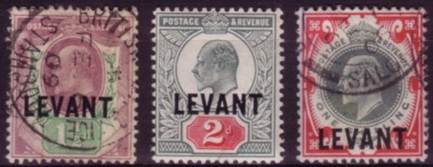
| (SG №) | denomination | colour | date of issue | number issued |
| L3a | 1½d | green and purple | 6 March 1908 | 70,800 |
| L4a | 2d | red and green | unknown | 81,840 |
| L10a | 1s | green and red | 6 March 1908 | 15,000 |
11,760 copies each of the 3d and 6d stamps were also prepared for issue on chalky paper, and were included in the “specimen” sets, but in the end they were not issued and all copies were destroyed. A few examples have appeared on the market but experts deem them forgeries.
1911 New printer, Harrisons
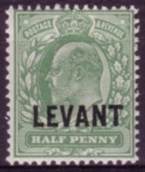
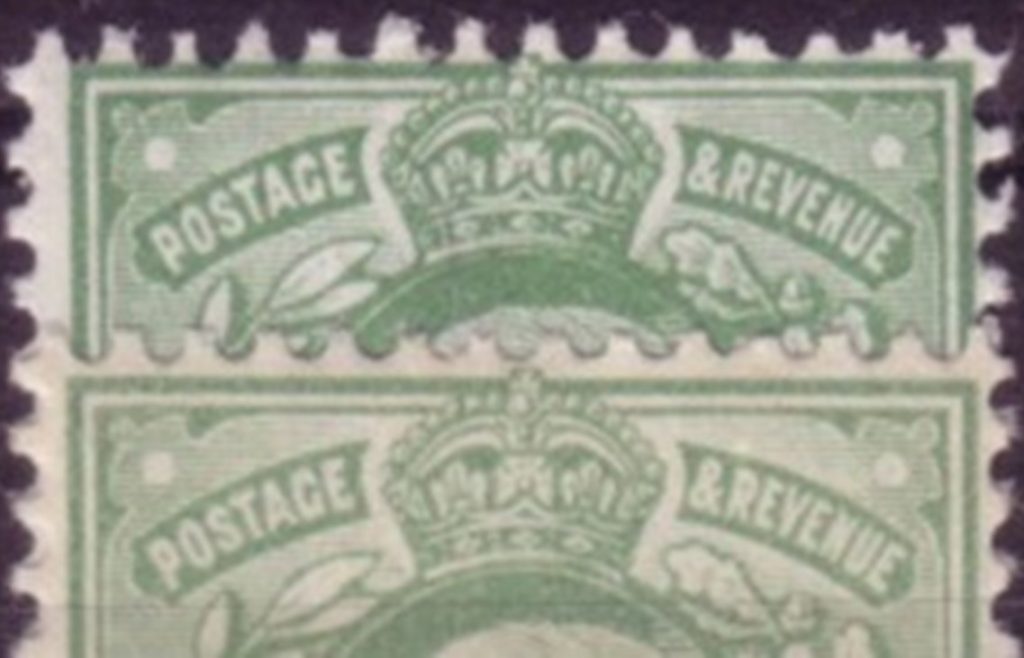
| (SG №) | denomination | colour | date of issue | number issued |
| L11 | ½d | green | Feb 1912 | 12,000 |
King George V
Die 1A, watermark crown
The “Die IA” stamps can be distinguished from “Die II” below as follows:
Die IA ½d heavy beard, 1d mostly unshaded lion,
Die II ½d light beard, 1d shaded lion
The dies were engraved in the light of public criticism of the heavy beard and the apparently underfed lion.
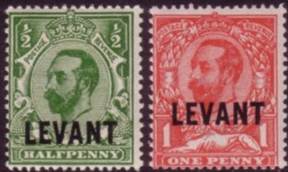
| (SG №) | denomination | colour | date of issue | number issued |
| L12 | ½d | green | 12 September 1911 | not recorded |
| L13 | 1d | red | 1 January 1912 | not recorded |
| Varieties | |||
| L12.v1 | ½d | distorted “N” | the distortion consists most noticeably by a large dint in the left leg of the “N”, stamps R2/10 and R12/10 |
| L13.v1 | 1d | distorted “N” | |
| L13.v2 | 1d | overprint double, one albino | Phillips (1931, Feb p.98) reports a part sheet on which the top nine rows and the top margin have an albino overprint, demonstrating that the overprint was done on each half of the sheet in turn. |
Die II, watermark crown
See previous table for the differences between Die IA and Die II.
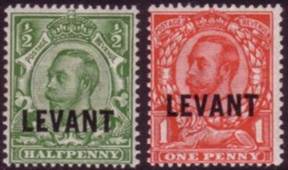
| (SG №) | denomination | colour | date of issue | number issued |
| L14 | ½d | green | 19 March 1912 | not recorded |
| L15 | 1d | red | 24 February 1912 | not recorded |
| Varieties | |||
| L14.v1 | ½d | distorted “N” | the distortion consists most noticeably by a large dint in the left leg of the “N”, stamps R2/10 and R12/10 |
| L15.v1 | 1d | distorted “N” | |
| L15.v2 | 1d | overprint double/treble, one/two albino | both varieties are recorded but may be the same item, especially if one of the albino overprints is faintly impressed |
Change to MacKennal portrait
The portrait was changed due to continued public dislike of the ¾-profile Downey head above.
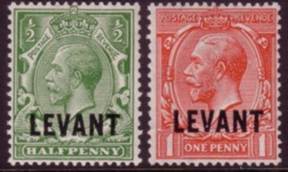
| (SG №) | denomination | colour | date of issue | number issued |
| L16 | ½d | green | July 1913 | not recorded |
| L17 | 1d | red | July 1913 | not recorded |
| Varieties | |||
| L16.v1 | ½d | distorted “N” | the distortion consists most noticeably by a large dint in the left leg of the “N”, stamps R2/10 and R12/10 |
| L17.v1 | 1d | distorted “N” | |
| L17.v1 | 1d | watermark doubled, one inverted | errors such as this are caused by pressure between two sheets, as it is not possible to manufacture paper with two watermarks; one sheet was recorded in Phillips |
After World War II
With the reopening of the British post office in Constaninople new denominations were added. As these were intended for use on parcels most used examples have a typical heavy barred cancellation or a boxed parcel post cancellation; experts consider those with normal cancellations to be philatelic.
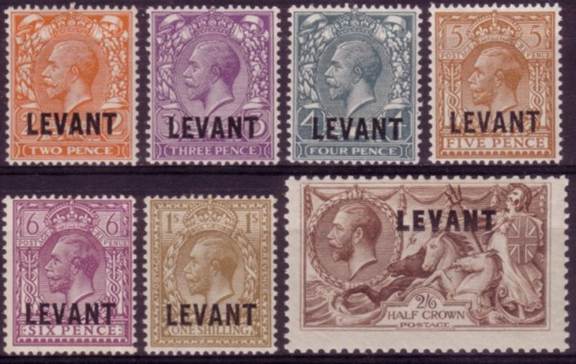
| (SG №) | denomination | colour | date of issue | number issued |
| L18 | 2d, die I | orange | 1921 | not recorded |
| L19 | 3d | violet | 1921 | not recorded |
| L20 | 4d | green-grey | 1921 | not recorded |
| L21 | 5d | brown | 1921 | not recorded |
| L22 | 6d | purple | 1921 | not recorded |
| L23 | 1s | brown | 1921 | not recorded |
| L24 | 2/6d (Bradbury Wilkinson printing) | brown | 1921 | not recorded |
| Varieties | |||
| L24.v1 | 2/6d | ribbed paper | this is not formally laid paper but has a definitely ribbed texture |
Salonica field force
In 1916 it was planned to issue stamps for a civilian post office in Mount Athos (Greece), but when this project was dropped the stamps were sent to be used by a British Army Field post office in Salonica (Thessaloniki). They were a personal initiative of the staff in the field post office and were not authorised by London, and some collectors regard them as unauthorised and do not collect them. As soon as the London GPO became aware of them they ordered their withdrawal: the table below indicates how many were sold before the withdrawal as well as the initial printing. However covers are known (including examples of the errors shown below) which did genuine postal service, albeit often philatelically inspired. For this reason some collectors regard them as not formally issued and not to be collected.
The catalogues rightly point to the abundant existence of forgeries of these, some dating to soon after their issue. Some of these forgeries exist on block watermark paper or on the wrong stamps, and are even stamped with forged expert authentication marks. Sometimes forgeries are very convincing, but others are very poor fantasies.
It is not certain whether some of the overprint varieties listed below were accidents or deliberately contrived for philatelic purposes.
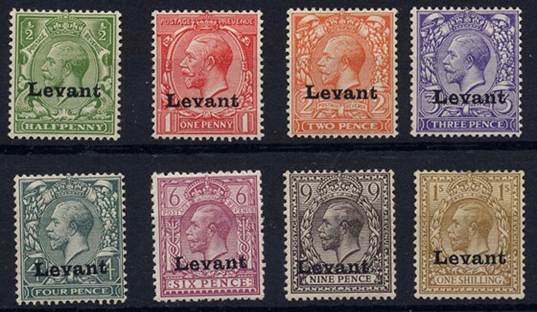
| (SG №) | denomination | colour | date of issue | number printed (sold) |
| S1 | ½d | green | February 1916 | 3,000 (1,352) |
| S2 | 1d | red | February 1916 | 2,880 (1,446) |
| S3 | 2d | orange | February 1916 | 480 (480) |
| S4 | 3d | violet | February 1916 | 720 (620) |
| S5 | 4d | green-grey | February 1916 | 480 (480) |
| S6 | 6d | purple | February 1916 | 1,440 (840) |
| S7 | 9d | black | February 1916 | 360 (360) |
| S8 | 1s | brown | February 1916 | 360 (360) |
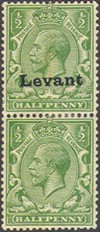
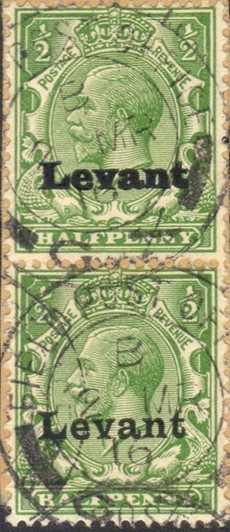
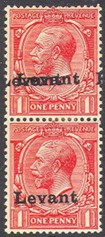
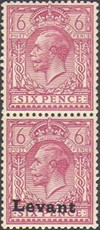
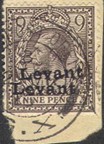
| Varieties | |||
| S1.v1 | ½d | overprinted omitted | vertical pair with normal overprint |
| S1.v2 | ½d | overprint double | |
| S2.v1 | 1d | overprint double | |
| S6.v1 | 6d | overprinted omitted | vertical pair with normal overprint |
| S7.v1 | 9d | overprint double |
The 3d “overprint double” in earlier catalogues is now believed not to exist.
Gibbons catalogues note that: “All values can be found with an additional albino overprint, inverted on the gummed side”, and sometimes also reversed; apparently caused by the overprinter using sheets as an “underlay” for those being overprinted for some reason. Simply accidentally putting two sheets through at once would have created the more normal “overprint double, one albino” found on other issues. Alternatively if one or more rows was folded under to act as such padding that would automatically make the albino overprint inverted. These are not listed separately in the table of varieties above. On copies seen in the Rossi auction (2005) these albino overprints are often almost invisible.
References specific to this chapter
GBOS GB Overprints Compendium edition 8, Dr John Gledhill (12/4/2020)
Particular thanks go to Stanley Gibbons Ltd, for permission to quote their catalogue numbers and numerous other contributors who are mentioned in the Appendix section.
All content is copyright, Dr John Gledhill and the GB Overprints Society, May 2025.
GBOS Study Papers:
British Levant No 1 Queen Victoria Issues, R. Malim (Revised January 1998)
British Levant No 2 Edward VII Issues, R Malim (Revised March 2000)
British Levant No 3 George V Issues 1911/1914 & Salonica Issue 1916, R Malim (January 1981)
British Levant No 4 Overprinted Issues for the Constantinople Post Office 1921-3, R Malim (January 1981)
British Levant No 5 Postal Stationery, R Malim (May 1985)
British Levant No 6 Cancellations and Cachets, R Malim (Revised November 1995)
British Levant No 7 Rates and Miscellaneous Matters, R Malim (Feb 1993) with revised Part 1 Section A (November 199
[1] This is the legal term customarily used for this action; it means simply that the Turkish authorities withdrew from all the previous agreement.
